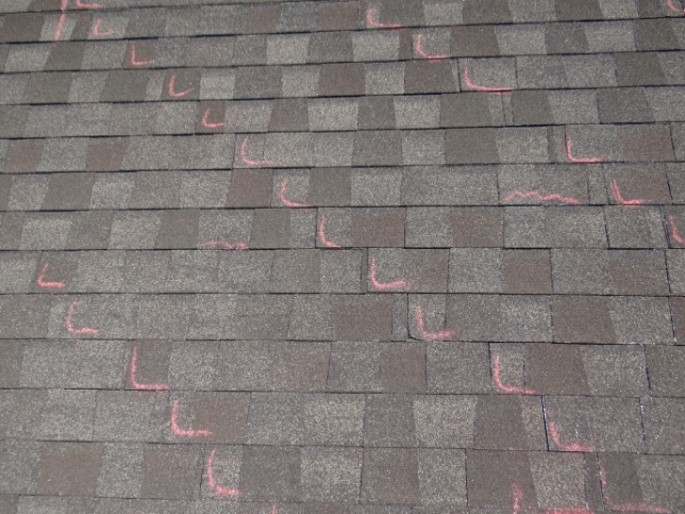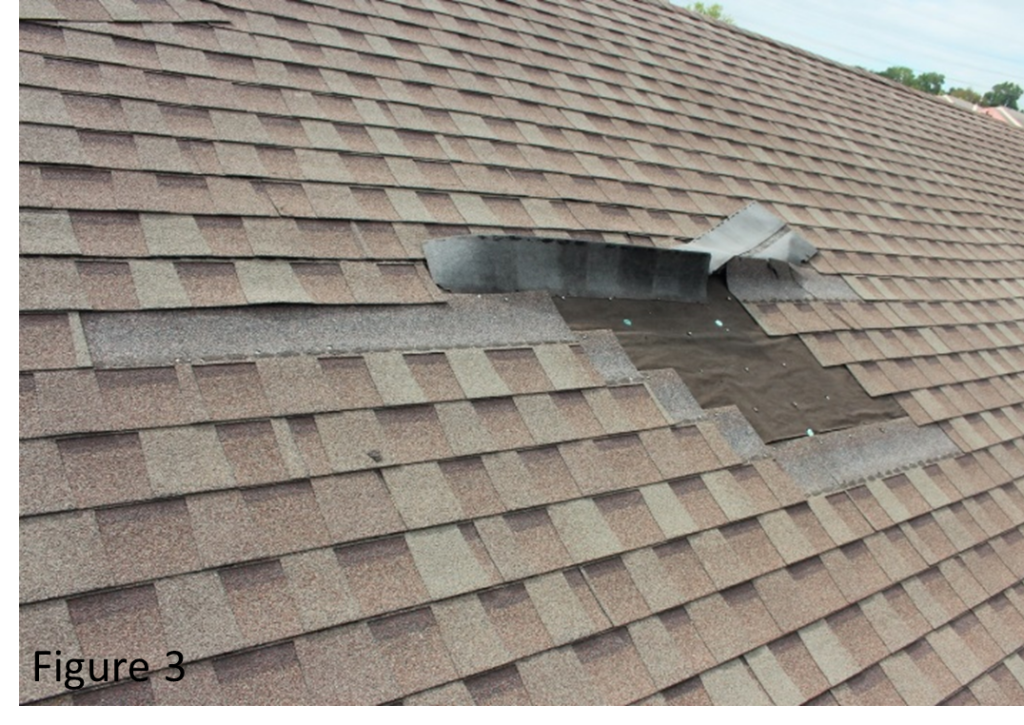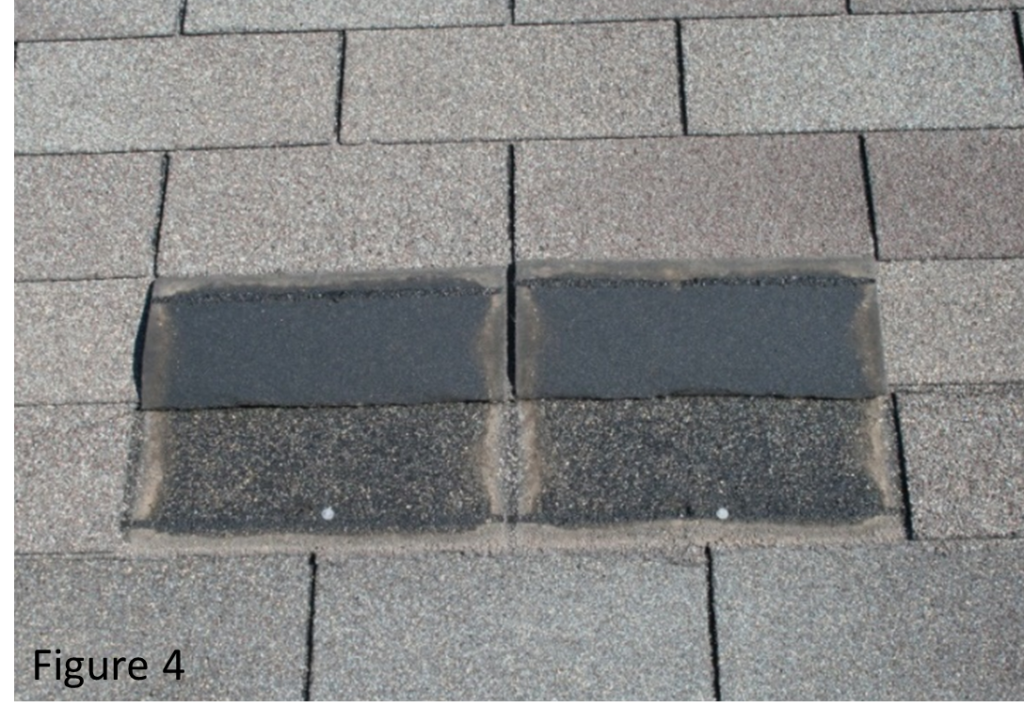By Amber Prom, P.E., Director of Curriculum, Forensic Engineer
Identifying the cause of property damage can sometimes be a hefty task. In many cases, damage that appears to have been caused by one thing, upon closer investigation, was caused by something entirely different. In this installment of “Property Damage Myths & Misconceptions”, we are going to take a look at ‘zippering’ of asphalt composition shingles and dig into exactly what causes this phenomenon.
Wind Zippering
When it comes to asphalt composition shingle roofing, it is difficult to find a property inspector who has not been on an asphalt shingle roof and observed long diagonal or zig-zag runs where the end of each shingle has become detached from the roof surface. This condition creates a stair-step or zipper-like pattern of partial shingle detachment across the roof surface and is very often labeled as wind-related damage to the roofing. But is this condition actually caused by wind? Let’s take a deep dive and see if we can figure out just what causes this ‘zippering’ effect.
‘Zippering’ is a common condition found on residential roofs with asphalt composition shingles. In fact, all asphalt shingle roofs will eventually develop some level of ‘zippering’ unless the adhesive is so tenacious, that instead, the shingles develop tears or splits. The condition consists of diagonal or vertical runs of partially detached shingles that create a stair-step or zipper-like pattern across the roof’s surface, as can be seen in Figures 1 and 2. When observed on a roof, it is not uncommon for that condition to exist across all of the roof slopes, with the only portion of the shingle that has become detached being the bottom corner of just one end of each shingle.


When trying to determine the cause of this patterned condition, many inspector’s minds go straight to wind. This is no surprise as wind does apply an uplift force on the roof covering, which can detach shingles if the wind is strong enough. However, when wind is the cause of the shingle detachment, the bottom edge of the shingle suddenly becomes detached at the shingle’s sealant strip due to the wind applying sufficient uplift force to cause sealant failure. Once the bottom edge detaches, the shingle either lifts and tears out around the nails, or the individual shingle tabs will lift and fold at their first point of restraint, which is the bottom edge of the overlying shingle, very close to where the top of the shingle is nailed down as shown in Figures 3 and 4.


In fact, if we think about the way wind acts on a roof, the mere detachment of just the corners of each shingle, with no folding, creasing, or tearing of the shingles, doesn’t really make sense for a number of reasons.
For one, wind pressures across a roof surface are highest near the perimeters of the roof facets, so near the roof eaves, rakes, hips, and ridges. Wind pressures gradually decrease and are lowest out in the middle of the field of the roof. With this in mind, one would expect for wind-related damage to occur where the wind pressures are greatest, not in straight or diagonal lines across the area of the roof that experiences the lowest wind pressures.
Secondly, while the wind pressures across the roof surface will vary, the wind uplift pressures experienced by any given shingle/shingle tab will be relatively uniform and even across that shingle’s exposed surface. Wind does not pull up on just one particular spot or area of a shingle. As a result, the pulling action of the wind will most often cause uniform detachment of the entire sealant strip, rather than a pulling action that initiates or concentrates at one corner of the shingle, detaching only a small portion of the sealant strip.
And finally, wind force on a shingle does not stop once the sealant strip has failed. Because of this, a detached shingle or shingle tab will lift from the surface of the roof, becoming creased, torn, or completely detached from the roof surface when wind is involved. If a wind pressure is strong enough to fail the sealant strip, then it is most certainly strong enough to lift a shingle that is no longer sealed down to the roof surface and at minimum crease or tear it.
The fact of the matter is, when we see this ‘zippering’ of the shingles occur, all we see is mere detachment of just the far end of the shingle, with no creasing, tearing, or displacement, which would be all but impossible if wind was the cause for the sealant failure itself. In fact, the mere presence of shingles that are detached from the roof’s surface, but do not exhibit creasing, folding, or tearing is a great indicator that the roof has not experienced very high winds because if it had, those shingle tabs that were not attached down to the roof surface would surely have lifted and folded even under lesser wind speeds. In no scenario will the wind apply an intense pressure, causing detachment of the sealant strip, and then immediately stop at that moment of failure, and gently set that shingle back down uncreased because wind speeds change gradually over several seconds and not instantaneously.
So, if not wind, what is causing this phenomenon? What is causing this specific pattern of localized detachment of the shingles with no associated creasing or tearing? The answer to that question is most often good old cyclic expansion and contraction. Although it may be hard to see or even visualize, every material expands and contracts under variations in temperature, some materials far more than others. The wood framing and roof decking also expand and contract with changes in humidity. For this reason, structures are constantly moving and differential movement between building elements has consequences.
In the case of asphalt composition shingles, each shingle is adhered to two adjacent underlying shingles, as shown in Figure 5.

The overlying pink and purple shingles are attached via their black sealant strip to two underlying green and blue shingles. As you can see, the joint between the two underlying shingles lies just to the right of the left end of the purple shingle. As the blue and green shingles contract (shrink), they pull away from one another and this causes stresses to build in the purple shingle that is sealed down to both the green and blue shingle. In many cases, the roofing materials can resist these stresses and nothing happens. But over time, cyclical stresses in the sealant strip eventually cause the adhesive to unbond. Due to the shorter length of engagement, the portion of the sealant strip near the left corner (shown in red) will fail, releasing from the green shingle. This mechanism occurs several times each day with temperature changes, cloud cover variations, surface cooling from rain, etc. Nearly every shingle on the roof will eventually have this small segment of adhesive detachment causing a stair-step or zipper like pattern across the roof, which follows the pattern the shingles were installed.
As you can see, in every location where a pink or purple shingle tab is attached down to both a blue and a green shingle, the shorter portion of the sealant strip detaches. And similarly, in every location where a blue or green shingle tab is attached down to both a pink and purple underlying shingle, the shorter (left) end of the sealant strip detaches, causing a ‘zippering’ pattern across the roof’s surface.
If the shingles were installed in the opposite direction but still in a diagonal fashion, the right end of the shingles would exhibit this detachment, as shown in Figure 6. And if the shingles were installed in a ‘straight-up’ or ‘racked’ pattern, the detachment will exhibit a zig-zag pattern in a vertical column, as shown in Figure 7. Regardless of the installation method, the end of each shingle that overlaps the joint between two underlying shingles is where the detachment occurs. And because these are shrinkage stresses at play rather than uplift forces, there is no lifting, folding or creasing of the shingles where they’ve become detached.


So, there you go folks – the wind-related zippering of asphalt shingles has been debunked. The culprit of this phenomenon is not wind, but rather cyclic expansion and contraction. So, next time you are out on roof, and you observe this ‘zippering’ effect, you will know exactly what is going on.
A few things to note about this condition: While the partial detachment of the shingles is not initially caused by wind, once the detachment occurs, the shingles become more susceptible to becoming wind damaged. Any portion of a shingle that is no longer sealed down to the roof can be lifted off the roof surface and creased or torn by wind pressures at much lower wind speeds. An easy solution to prevent this from happening is hand-sealing any locations you find that exhibit detachment at the sealant strip.
If you’d like to learn more about the subject, you can read a more thorough article written by Dr. Carlos Lopez, PhD; Jonathan S. Goode, PhD, PE; and Scott R. Morrison, PE, titled Misconceptions of Wind Damage to Asphalt Composition Shingles. Or you can enroll in our Haag Certified Inspector- Wind Damage Course and become a Haag Certified Wind Inspector yourself, which can be found at www.HaagEducation.com.
Stay tuned for another case of “Property Damage Myths & Misconceptions” by checking in on the Haag Global Blog or by enrolling to receive our Haag monthly newsletter!
Author

Amber Prom, P.E., Director of curriculum
Amber M. Prom, P.E., is Haag’s Director of Curriculum and is based out of the greater Denver area. Ms. Prom is a Registered Professional Civil/Structural Engineer with 18 years’ experience in structural design, project management, forensic engineering, and engineering management/training. After working in the design field for approximately 8 years, Ms. Prom worked in the field of forensics as a Professional Development Manager and Principal Consultant for approximately 10 years. As a Professional Development Manager, she was responsible for training all newly hired Civil/Structural Engineers and Building Consultants and providing continuing education/training for existing experts. As a Project Engineer/Principal Consultant, she conducted forensic engineering investigations related to structures which had failed, become damaged, did not operate/function as intended, or were constructed deficiently. Most of her investigations involved hail damage to structures caused by wind, hail, tornados, hurricanes, and earthquakes, along with fires, explosions, ground vibrations, and construction defects. Ms. Prom has also been engaged as an expert witness in numerous mediations, arbitrations, depositions, and trials throughout her career. Currently, Ms. Prom acts as Haag’s Director of Curriculum and develops/manages all of Haag Education’s training curriculum, including the Haag Certified Inspector and Haag Certified Reviewer Programs.
Any opinions expressed herein are those of the author(s) and do not necessarily reflect those of Haag Technical Services, Haag Engineering Co., Haag Education, or parent company, Haag Global, Inc.

